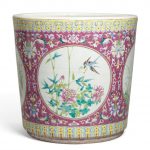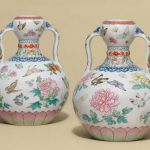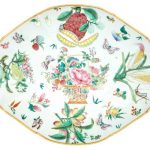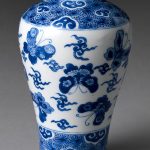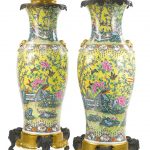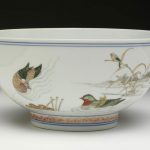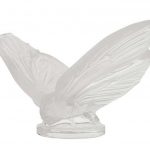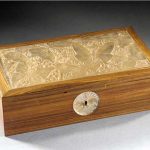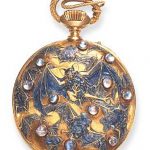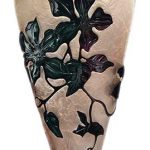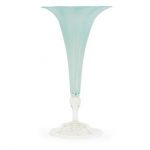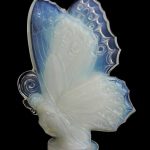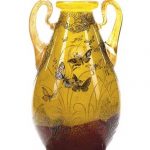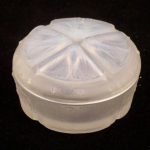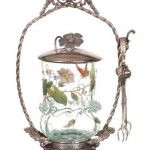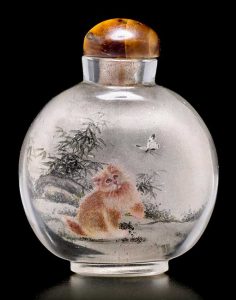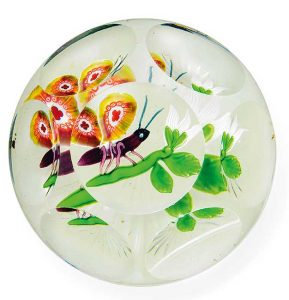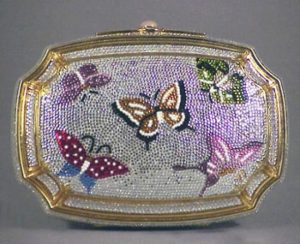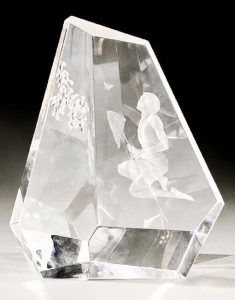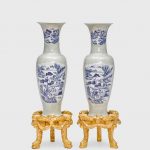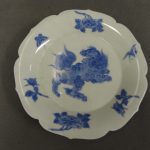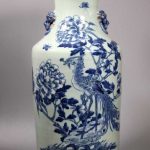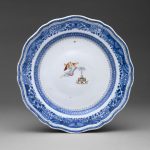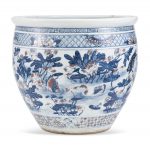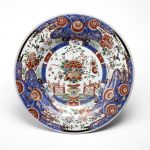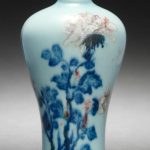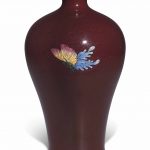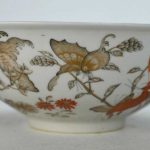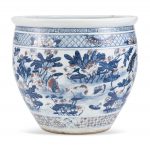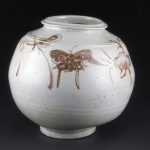The post Chinese Blue and White Porcelain appeared first on Antique Butterflies.
]]>Below are some examples and price guides of antique Chinese blue and white porcelain including a Kangxi pot and a fine porcelain snuff bottle.

Chinese Blue and White Kangxi Pot and Cover,
1662-1722,
squat bulbous shape with metal handles and finial, underglaze decorated with a mountainous landscape with figures on one side, the reverse with a flower garden with insects, approx. overall dia. 8 3/4, ht. 8 1/4 in.
Sold for Sold for US$6,400 inc. premium at Bonham’s in 2023
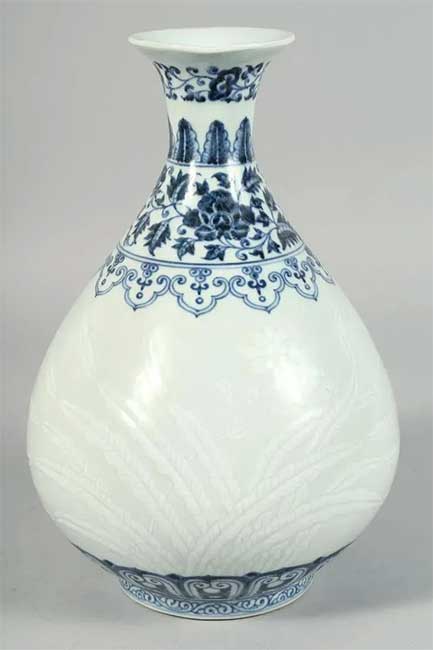
CHINESE BLUE AND WHITE PORCELAIN YUHUCHUNPIN VASE, the body with raised decoration depicting sprays of flora and butterflies, the neck with a band of blue and white foliate decoration, six-character mark to base, 30cm high.
Sold for US$300 at Royal Sea LLC in 2023
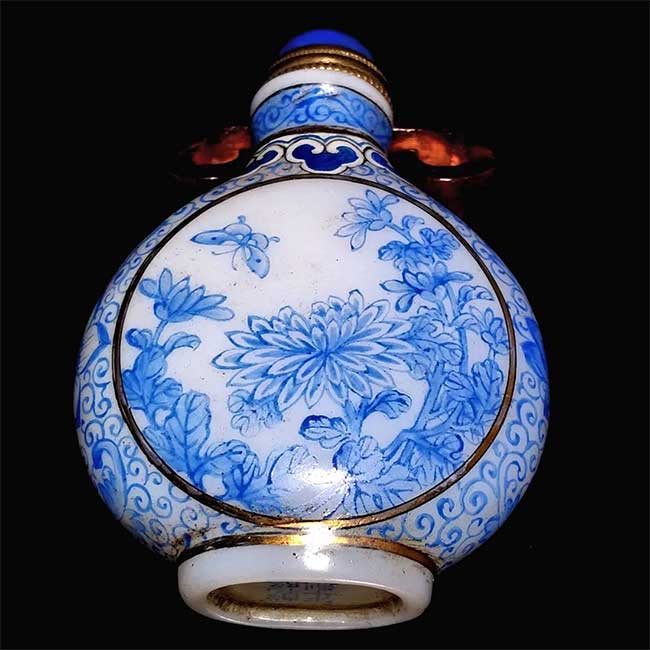
FINE CHINESE BLUE WHITE ENAMEL SNUFF BOTTLE POEM QIANLONG MARK
This blue and white bottle is finely enameled and features a floral scene with a butterfly on one side and a poem on the other. There are also fine gilding touches. It bears the Qianlong mark and is 2.8 inches tall.
Sold for US$120 at Noble House Collection Gallery in 2023
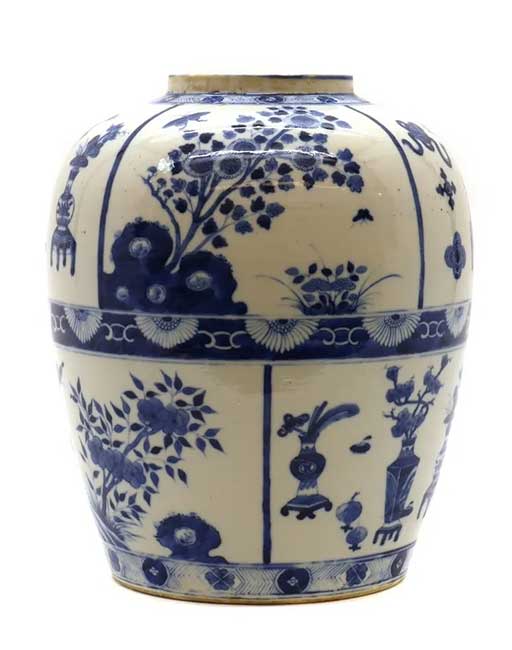
A Chinese blue and white jar, Kangxi (1662-1722), of ovoid form, painted with precious objects, butterflies and flowers in shaped panels, 26cm high Condition Report: Signs of glue to rim.
Sold for £820 at Sworders Fine Art Auctioneers in 2023
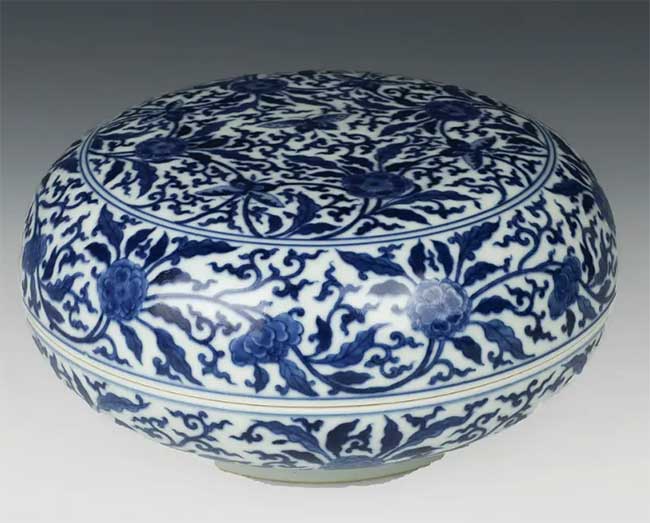
Blue And White Butterfly Pattern Holding Box, Kangxi Mark
Sold for CA$250 at Arnaud’s Auctions and Appraisals LIMITED in 2023
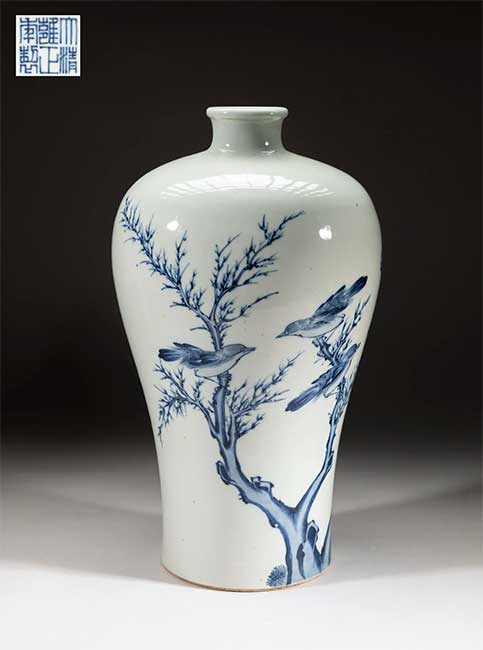
Rare Chinese Blue & White Porcelain Vase
Of tall baluster form, the exterior painted with birds, butterflies and gnarled tree branches, the bottom inscribed with six-character mark. Approx. 12.4-7 inch.
Sold for US$3,250 at Wealthier Art & Auction in 2023
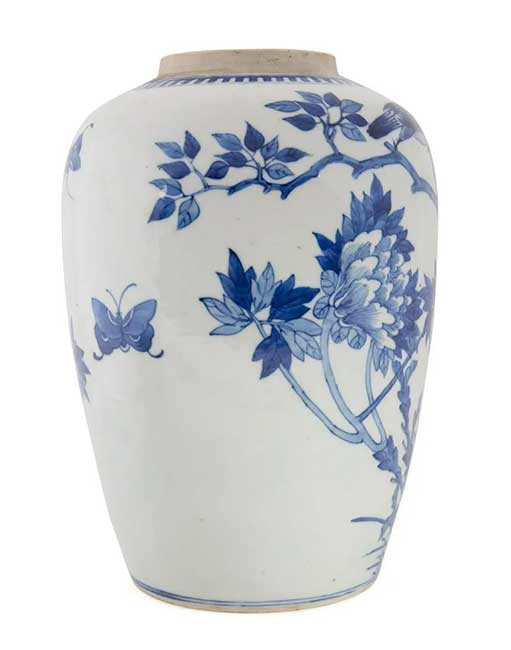
Chinese blue and white bird and flower jar, of ovoid form, decorated with a pair of bulbuls perched in a peony bush with rockwork to the side and butterflies floating above, having no apparent mark.
Approximate dimensions: h. 11″, dia. 7″.
Sold for US$450 at Ahlers & Ogletree Auction Gallery in 2023
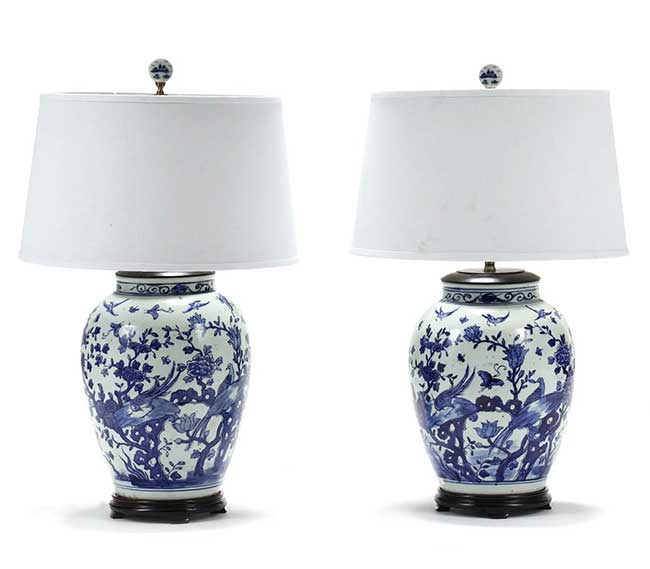
A Pair of Large Chinese Porcelain Blue and White Table Lamps
contemporary, large ginger jars painted with birds, flowers and butterflies in blue, drilled and set into wood mounts as lamps with single lightbulb fixture, fabric lampshades, and decorative porcelain disc finials with blue landscape scene, label stickers remain to body of lamps.
Sold for US$375 at Leland Little in 2023
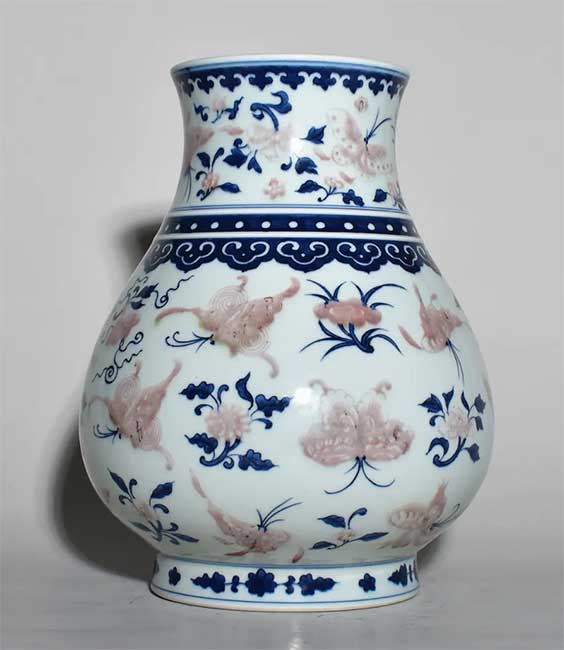
Blue and white vase with butterfly pattern of the Qing Dynasty
Sold for US$3,750 at YaShawn Auction House in 2023
The post Chinese Blue and White Porcelain appeared first on Antique Butterflies.
]]>The post Polychrome appeared first on Antique Butterflies.
]]>Below are some examples and price guides of polychrome antiques decorated with butterflies including a Bristol glass vase and a Qianlong snuff bottle.
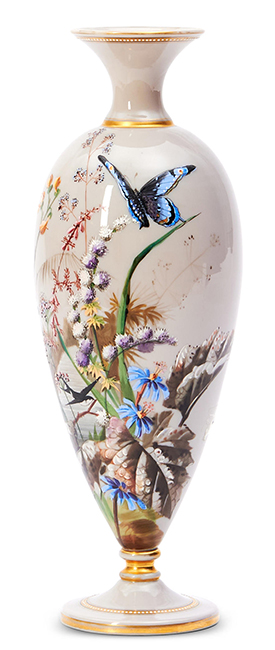
Bristol Glass Hand Painted Vase,
England, 19th century,
light grey ground with polychrome enamel decorated birds, butterflies and flowers, ht. 16 1/4 in.
Sold for Sold for US$204 inc. premium at Bonham’s in 2022
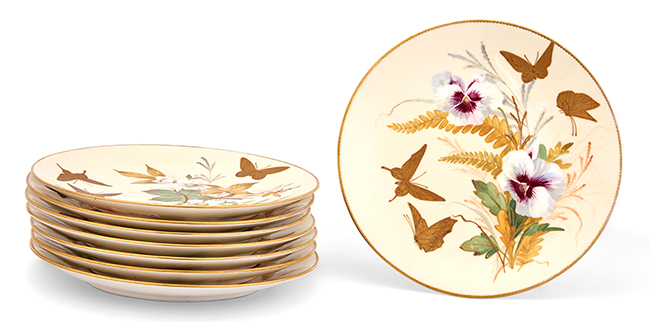
Set of Eight Edward F. Bodley Aesthetic Movement Gilt and Polychrome Decorated Porcelain Dessert Plates
Circa 1880-90
In the Japanesque style, variously decorated with flowers and butterflies in flight, against an ivory colored ground.
Diameter 9 1/4 inches.
Sold for $756 (includes buyer’s premium) at Doyle in 2022
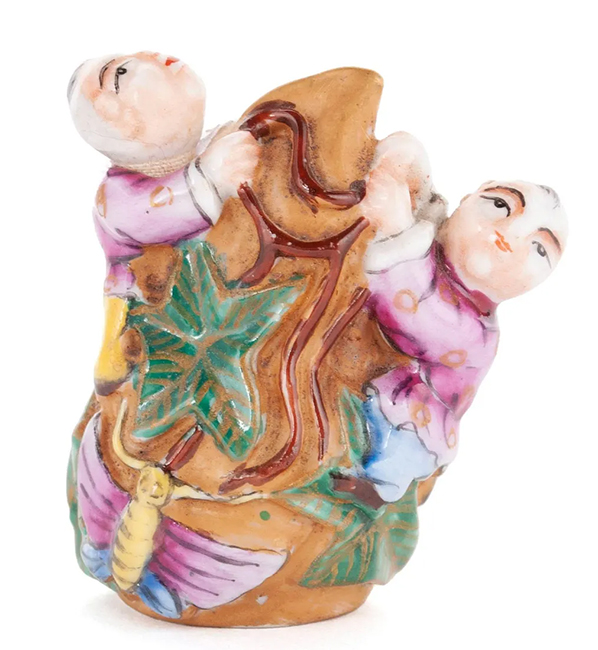
A RARE ‘TWO BOY’ QIANLONG SNUFF BOTTLE
Chinese, Qing Dynasty, polychrome enameled porcelain. In the figural form of two young boys climbing a vine wrapped boulder above a butterfly, the underside having an iron red, four-character Qianlong reign mark to underside.
Bottle: 1 7/8 in. (4.76 cm.)
35 grams
Sold for US$100 at Selkirk Auctioneers & Appraisers in 2023
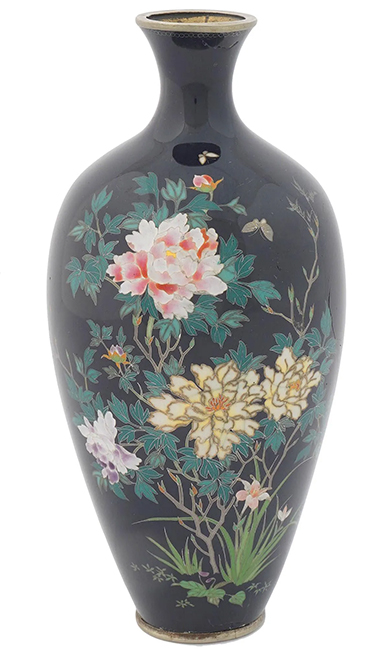
An antique Japanese Meiji Era brass and enamel vase. Circa: early 20th century. The baluster form vase is enameled with polychrome images of blossoming flowers and plants, and butterflies made in the Cloisonne technique on a black ground. Marked with an impressed stamp with Hieroglyphs on the bottom.
Sold for US$200 at Antique Arena Inc. in 2023
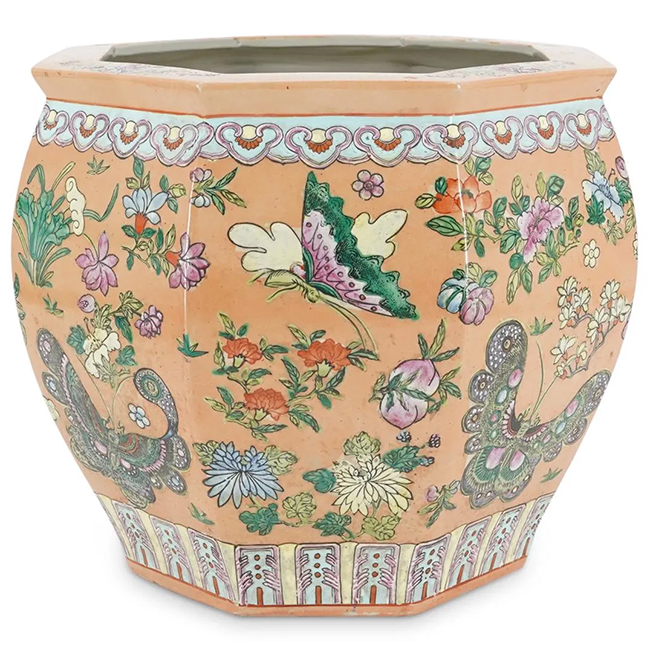
Antique Chinese porcelain planter decorated with polychrome enameled depictions of butterflies among flowers over a peach toned ground, completed by light blue and pink arch patterns in a band around the rim and foot.
Red character markings at the underside.
CIRCA: Early to Mid 20th Century
ORIGIN: China
DIMENSIONS: H: 11.75″ D: 14.5″
Sold for US$650 at Akiba Galleries in 2022
The post Polychrome appeared first on Antique Butterflies.
]]>The post Ceramic appeared first on Antique Butterflies.
]]>Below are some examples and price guides of ceramic antiques including a Majolica butterfly and orchid dressing table tray and a Doulton Lambeth stoneware oil lamp.
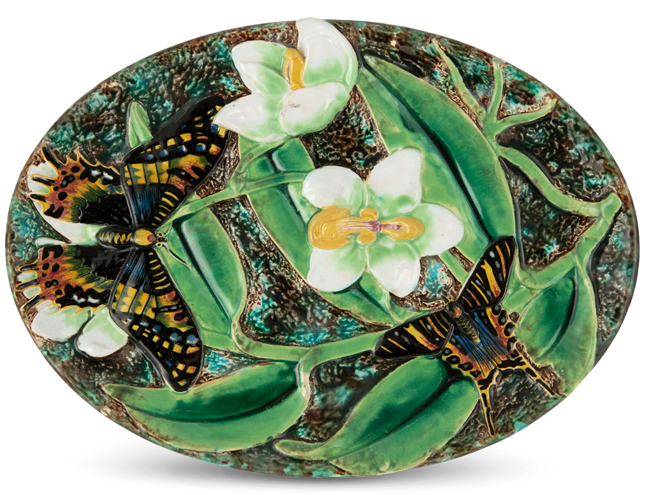
George Jones Majolica Butterfly and Orchid Dressing Table Oval Tray
Circa 1874
Impressed GJ monogram mark, B6 and 6 raised registry diamond (18-U-A-8) for 18 December 1874, black painted x
Naturalistically molded with two outstretched swallowtail butterflies and flowering white orchids. Length 11 inches.
Part of an eight-piece dressing table set.
Sold for $4,095 (includes buyer’s premium) at Doyle in 2021
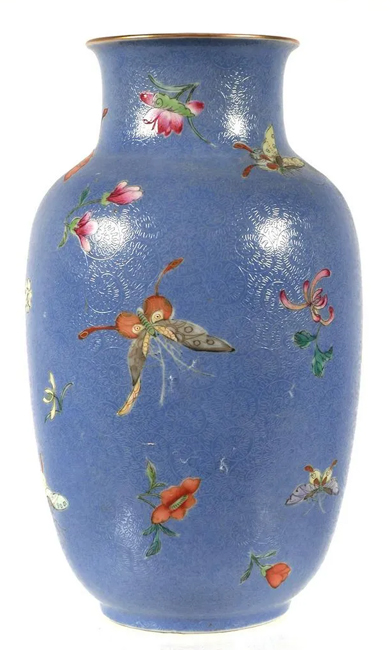
20th Century Chinese ceramic vase in with a textured / sgraffito periwinkle blue with butterfly and floral details, marked Made in China on bottom, measures 8 1/8 inches high.
Sold for US$475 at Blackwell Auctions in 2022
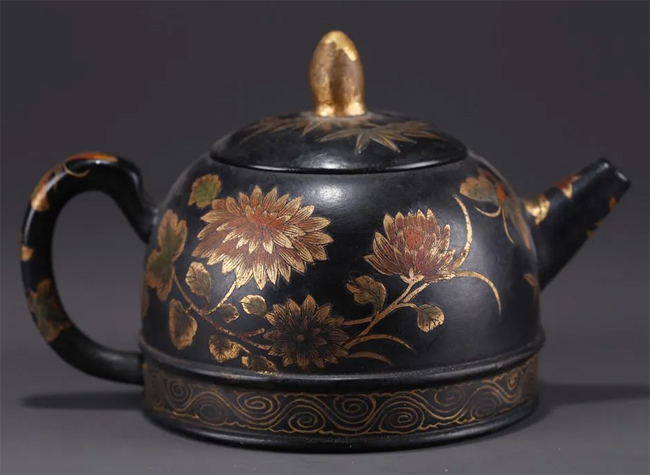
Purple Clay Handled Pot with Golden Flowers and Butterflies Design.
Dimensions
9 x 15 cm
Sold for US$1,600 at Top Notch Collections in 2022
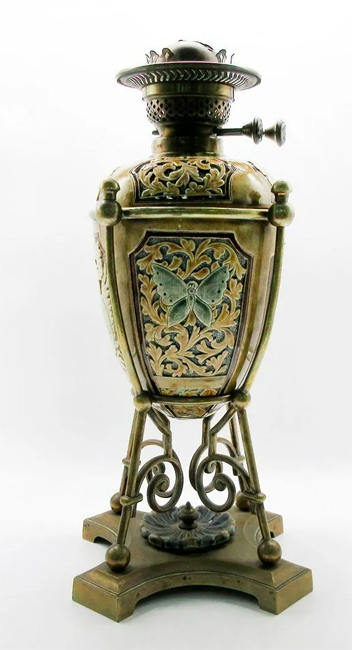
Doulton Lambeth Mark V Marshall Stoneware Oil Lamp
Antique 19th century ceramic relief body decorated with owls and butterflies mounted on metal stand.
Doulton Lambeth marks, artist’s monograms.
Sold for US$600 at Lion and Unicorn in 2022
The post Ceramic appeared first on Antique Butterflies.
]]>The post Kakiemon appeared first on Antique Butterflies.
]]>The style was quickly copied by the new European porcelain factories that appeared in the 18th century, such as Meissen in Germany, Chantilly in France and Chelsea in England. The Chinese also began to copy the style for Chinese export porcelain. By about 1760 it had largely fallen from fashion in Europe. Reference: Wikipedia
Below are some examples and price guides of Kakiemon antiques which have butterflies as part of their design including an octagonal bowl.
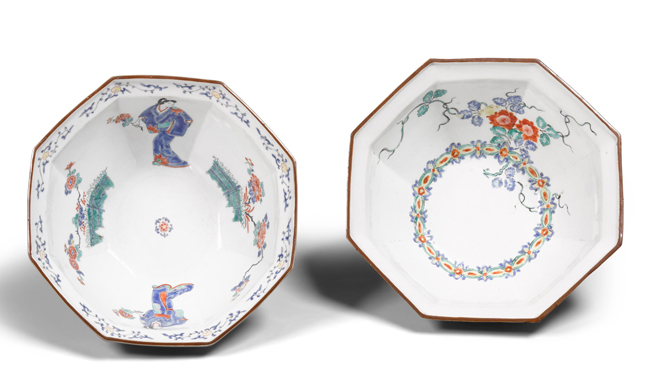
Two octagonal porcelain bowls
Hizen ware, Kakiemon type
Edo period (1615-1868), 18th century
Each painted in red, yellow, blue, green, and black enamels with a chocolate-brown rim, the first decorated on the interior with two Kanbun beauties holding sprays of flowers and blossoming peonies and chrysanthemums behind a brush fence, the exterior a squirrel on grape vines on a bamboo trellis and butterflies above flowers and rocks, the second decorated on the interior with flowering vines rising from a band of linked blossoms encircling the cavetto, the exterior with scattered cherry blossoms
8 1/2in (21.6cm); 8 3/8in (21.2cm) diameter
Sold for Sold for US$2,167.50 inc. premium at Bonham’s in 2021

Japanese Arita Kakiemon octagonal porcelain serving bowl. Deep bowl with flaring mouth-rim, Inside decorated with butterflies, Ho Ho bird, cloud and moon, flowers and leaves. The center is decorated with flowers surrounded by a doubled octagon. The mouth-rim has a cage-au lait enameling and next to that a band of flowers. The outside, flowers and bamboo trellis. Made by the Kakiemon Kilns. ca. 1725, 4 1/4″H x 8 3/4″diam
Sold for US$375 at Ripley Auctions in 2021
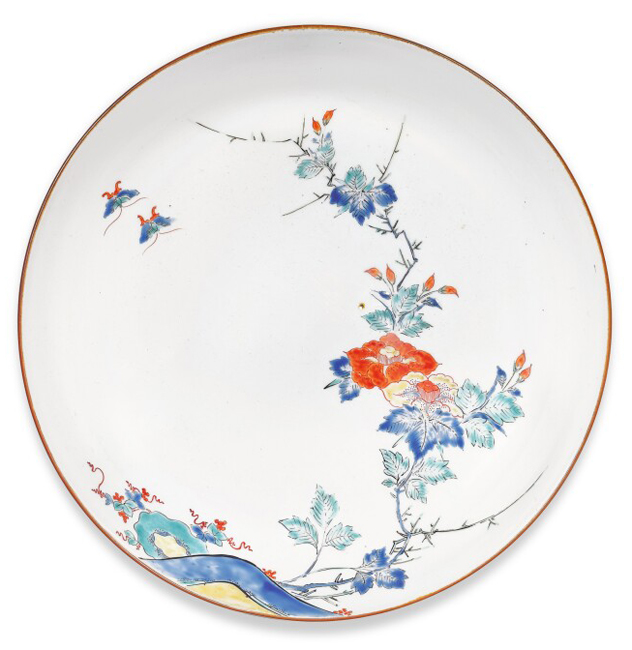
A KAKIEMON DISH
EDO PERIOD, LATE 17TH CENTURY
the shallow, circular dish decorated in iron-red, green, yellow, blue and black enamels with butterflies hovering beside tree peonies emerging from behind rockwork, chocolate rim
22 cm, 8 3/4 in. diam.
Sold for 15,120 GBP at Sotheby’s in 2020
The post Kakiemon appeared first on Antique Butterflies.
]]>The post Chinese Porcelain appeared first on Antique Butterflies.
]]>Eventually, porcelain and the expertise required to create it began to spread into other areas of East Asia. During the Song dynasty (960–1279 AD), artistry and production had reached new heights. The manufacture of porcelain became highly organised, and the dragon kilns excavated from this period could fire as many as 25,000 pieces at a time, and over 100,000 by the end of the period. While Xing ware is regarded as among the greatest of the Tang dynasty porcelain, Ding ware became the premier porcelain of the Song dynasty.
By the time of the Ming dynasty (1368–1644 AD), porcelain wares were being exported to Europe. Some of the most well-known Chinese porcelain art styles arrived in Europe during this era, such as the coveted “blue-and-white” wares. The Ming dynasty controlled much of the porcelain trade, which was expanded to Asia, Africa and Europe via the Silk Road. In 1517, Portuguese merchants began direct trade by sea with the Ming dynasty, and in 1598, Dutch merchants followed.
Some porcelains were more highly valued than others in imperial China. The most valued types can be identified by their association with the court, either as tribute offerings, or as products of kilns under imperial supervision. Since the Yuan dynasty, the largest and best centre of production has made Jingdezhen porcelain. During the Ming dynasty, Jingdezhen porcelain become a source of imperial pride. The Yongle emperor erected a white porcelain brick-faced pagoda at Nanjing, and an exceptionally smoothly glazed type of white porcelain is peculiar to his reign. Jingdezhen porcelain’s fame came to a peak during the Qing dynasty. Reference: Wikipedia
The post Chinese Porcelain appeared first on Antique Butterflies.
]]>The post Lalique appeared first on Antique Butterflies.
]]>Lalique Butterflies. Lalique is a French glassmaker, founded by renowned glassmaker and jeweller René Lalique in 1888. Lalique is best known for producing glass art, including perfume bottles, vases, and hood ornaments during the early twentieth century. Following the death of René, Lalique transitioned to producing lead glass (crystal) works during the 1950s while under the direction of René’s son, Marc Lalique. Since 2010, Lalique has been owned by Swiss company Art and Fragrance. Reference: Wikipedia
The post Lalique appeared first on Antique Butterflies.
]]>The post Opalescent Glass appeared first on Antique Butterflies.
]]>Opalescent Glass Butterflies. The term “opalescent glass” is commonly used to describe glass where more than one color is present, being fused during the manufacture, as against flashed glass in which two colors may be laminated, or silver stained glass where a solution of silver nitrate is superficially applied, turning red glass to orange and blue glass to green. Some opalescent glass was used by several stained glass studios in England from the 1860s and 1870s onwards, notably Heaton, Butler and Bayne. Its use became increasingly common. Opalescent glass is the basis for the range of glasses created by Tiffany. Reference: Wikipedia
Below are some examples of opalescent glass objects with butterflies as part of their design.
The post Opalescent Glass appeared first on Antique Butterflies.
]]>The post Crystal / Lead Glass appeared first on Antique Butterflies.
]]>Lead glass, commonly called crystal, is a variety of glass in which lead replaces the calcium content of a typical potash glass. Lead glass contains typically 18–40% (by weight) lead(II) oxide (PbO), while modern lead crystal, historically also known as flint glass due to the original silica source, contains a minimum of 24% PbO. Lead glass is desirable owing to its decorative properties.
Originally discovered by Englishman George Ravenscroft in 1674, the technique of adding lead oxide (in quantities of between 10 and 30%) improved the appearance of the glass and made it easier to melt using sea-coal as a furnace fuel. This technique also increased the “working period” making the glass easier to manipulate.
The term lead crystal is, by technicality, not an accurate term to describe lead glass, as being an amorphous solid, glass lacks a crystalline structure. The use of the term lead crystal remains popular for historical and commercial reasons. It is retained from the Venetian word cristallo to describe the rock crystal imitated by Murano glassmakers. This naming convention has been maintained to the present day to describe decorative hollow-ware.
Lead crystal glassware was formerly used to store and serve drinks, but due to the health risks of lead, this has become rare. One alternative material is crystal glass, in which barium oxide, zinc oxide, or potassium oxide are employed instead of lead oxide. Lead-free crystal has a similar refractive index to lead crystal, but it is lighter and it has less dispersive power. Reference: Wikipedia
The post Crystal / Lead Glass appeared first on Antique Butterflies.
]]>The post Underglaze Porcelain Butterflies appeared first on Antique Butterflies.
]]>
The post Underglaze Porcelain Butterflies appeared first on Antique Butterflies.
]]>The post Copper-red Porcelain Butterflies appeared first on Antique Butterflies.
]]>Copper-red porcelain butterflies. Copper-red glazes are glazes containing copper which turn red when fired in a reducing atmosphere. The earliest known copper-red glaze occurs on wares made in Shanxi during the Tang dynasty. Jun kilns of the Song dynasty commonly used copper glazes. The sacrificial xianhong of the early Ming dynasty and its Qing dynasty copies, the Qing dynasty jihong (same but of the period), langyaohong, Peach-bloom and the Qing Jun red, which was really a monochrome red of the flambé type are all copper based red glazes. Reference: Gotheborg.com
Below are some examples of copper-red porcelain decorated with butterflies.
The post Copper-red Porcelain Butterflies appeared first on Antique Butterflies.
]]>